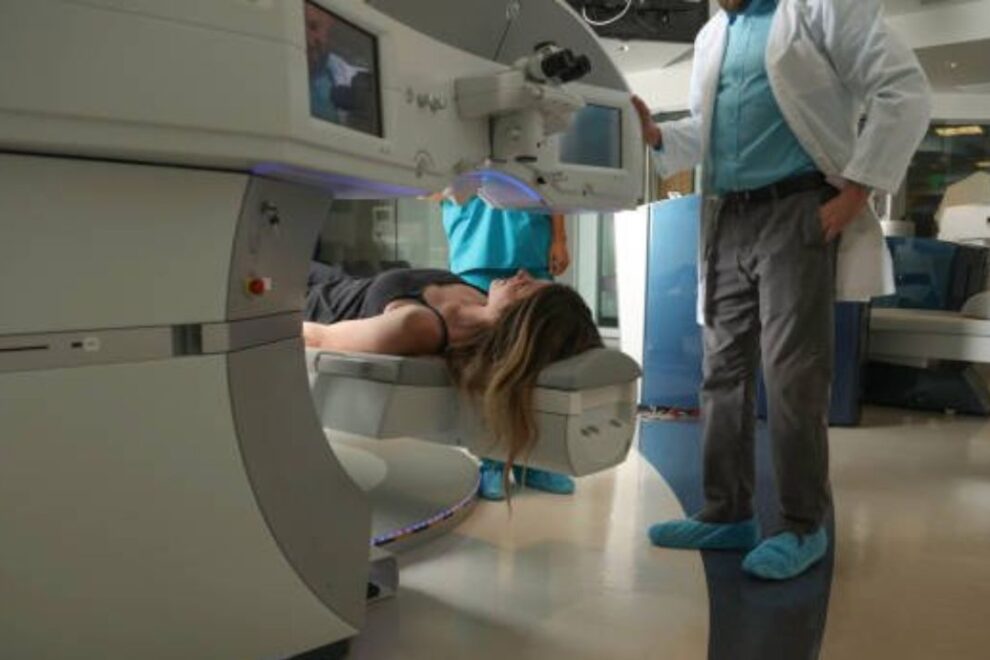Radiotherapy Surgery and Cost in India
Radiotherapy is the medical use of ionizing radiation as part of cancer treatment to control malignant cells (not to be confused with radiology, the use of radiation in medical imaging and diagnosis). Radiotherapy may be used for curative or adjuvant treatment. It is used as palliative treatment (where cure is not possible and the aim is for local disease control or symptomatic relief) or as therapeutic treatment (where the therapy has survival benefit and it can be curative). Total body irradiation (TBI) is a radiotherapy technique used to prepare the body to receive a bone marrow transplant


Free Doctor Opinion
What is Radiotherapy ?
Radiotherapy involves the use of carefully targeted doses of x-rays or other high-energy rays to kill cancer cells and shrink tumours. While given as a preventive measure for early cases of cancer, it is also administered as a palliative treatment for pain relief in advanced cases. Radiotherapy may be used alone or together with surgery or chemotherapy.
The most annoying and uncomfortable side effects of radiation therapy involve the skin of the area being treated. In many ways your skin reaction will be like a sunburn, with a mild to moderate pink color or redness, with itching, burning, soreness, and possible peeling. But unlike what happens with a sunburn, your skin will react to radiation very gradually and possibly only in patches.
Radiotherapy can be given in two ways, either as external beam radiotherapy (external radiotherapy) or as a radioactive implant (internal radiotherapy).
- External Radiotherapy : – This treatment involves the high energy rays being directed to the cancer by various machines which include cobalt 60, linear accelerator and betatron. The dosage and duration of the treatment depend on the patient’s weight and general health, the type, size and location of the tumour and whether surgery and chemotherapy have been used or are planned in the future. A typical course lasts 4 to 6 weeks with treatment for 5 days per week and a weekend break to allow time for normal cells to recover and rebuild. The attending physician checks the patient’s progress to measure the total radiation delivered.
- Internal Radiotherapy : – This kind of Radiation Therapy is given by inserting radioactive needles or wires into the tumour while the patient is under general anesthesia. Over a few days, a high dose of radiotherapy is given directly to the tumour from the inside rather than a lower daily dose from the external source over a longer period of time.
Wish to know our Cosmetic Surgery skills, send us your message Or email at [email protected] / Call +91 9029304141
Radiation therapy is commonly applied to the cancerous tumor. The radiation fields may also include the draining lymph nodes if they are clinically or radiologically involved with tumor, or if there is thought to be a risk of subclinical malignant spread. It is necessary to include a margin of normal tissue around the tumor to allow for uncertainties in daily set-up and internal tumor motion. These uncertainties can be caused by internal movement (for example, respiration and bladder filling) and movement of external skin marks relative to the tumor position.
One type of radiation therapy commonly used involves photons, “packets” of energy. X-rays were the first form of photon radiation to be used to treat cancer. Depending on the amount of energy they possess, the rays can be used to destroy cancer cells on the surface of or deeper in the body. The higher the energy of the x-ray beam, the deeper the x-rays can go into the target tissue. Linear accelerators and betatrons are machines that produce x-rays of increasingly greater energy. The use of machines to focus radiation (such as x-rays) on a cancer site is called external beam radiotherapy.
Gamma rays are another form of photons used in radiotherapy. Gamma rays are produced spontaneously as certain elements (such as radium, uranium, and cobalt 60) release radiation as they decompose, or decay. Each element decays at a specific rate and gives off energy in the form of gamma rays and other particles. X-rays and gamma rays have the same effect on cancer cells.
Wish to speak to us now? Send us a message and we will call you back Or email at [email protected] / Call +91 9029304141
Read Also :-
- Stenting for GI Tract Surgery: A Minimally Invasive Solution in Digestive Health
- Surrogacy Agency in India: Professional Guidance for Your Parenthood Journey
- Sigmoidoscopy Surgery in India: Early Detection and Affordable Care for Colon Health
- Advanced Spondylosis Surgery in India: Procedures, Costs & Leading Hospitals
- Stenting for GI Tract Surgery: A Minimally Invasive Solution in Digestive Health
- Sigmoid Colectomy in India: Advanced and Affordable Colon Surgery
Committed To Build Positive, Safe, Patient Focused Care.
High Quality
Care
Home Review
Medicine
All Advanced
Equipment
Book An Appointment

At We Care India, we offer complete medical services for your entire family, from routine check-ups to injury care, ensuring personalized attention and expert assistance for all your health needs.


